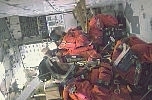
 |
| a part of a Shuttle's crew is seen buckled on the seats in mid-deck (Return to Flight Mission, STS-114). picture NASA/KSC |
![]()
![]() Comment l'équipage se prépare un jour de lancement
Comment l'équipage se prépare un jour de lancement
 |
| une partie des membres de l'équipage de la mission de Retour au Vol (STS-114, 26/07/2005) sur leurs sièges sur le pont intermédiaire de la navette. NASA/KSC |